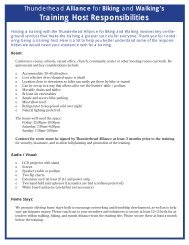2007 Benchmarking Report - Alliance for Biking & Walking
2007 Benchmarking Report - Alliance for Biking & Walking
2007 Benchmarking Report - Alliance for Biking & Walking
Create successful ePaper yourself
Turn your PDF publications into a flip-book with our unique Google optimized e-Paper software.
Bicycling & <strong>Walking</strong> in the U.S./ Thunderhead <strong>Alliance</strong> <strong>2007</strong><br />
102<br />
CONCLUSIONS<br />
(cont. from page 99)<br />
Greater Investment Needed<br />
Chapter 7 shows how policies have a direct impact on<br />
levels of cycling and walking. Land use policies (density), infrastructure,<br />
policies to encourage or discourage automobiles<br />
(among others) impact people’s decision to bike or walk. Cities<br />
and states that rank high <strong>for</strong> bicycle and pedestrian policies and<br />
provisions provide benchmarks <strong>for</strong> other states and cities to<br />
aspire to. However, the graph on pages 100-101 shows that all<br />
states fall behind in funding bicycling and walking in proportion<br />
to prevalence of these modes. Although bicycling and walking<br />
make up almost 10% of all trips, less than 2% of federal transportation<br />
dollars go to bicycle and pedestrian projects.<br />
Because so many variables likely factor into increased<br />
bicycling and walking levels (i.e. biking and walking facilities,<br />
education, secure bike parking, integration with transit, etc) and<br />
these variables are often dependent on other variables (i.e. funding<br />
and staffing levels, strong advocacy organizations, good policies),<br />
it’s difficult to point to any of these alone as the greatest<br />
need. Rather, looking at the states and cities that rank highest in<br />
some of these areas (Chapter 5) reveals that these places also<br />
rank among the highest <strong>for</strong> cycling and walking levels (Chapters<br />
3 and 4). These connections prove that investment in bicycle and<br />
pedestrian policies and provisions and biking and walking levels<br />
are linked.<br />
Limitations to this <strong>Report</strong><br />
The availability of reliable data, especially <strong>for</strong> all trips<br />
taken by foot and bicycle, limits what this report can show. The<br />
most reliable source of mode share data is from the 2005 American<br />
Community Survey (ACS). However, since this survey only<br />
looks at trips to work, it does not provide a complete perspective<br />
on all bicycling and walking trips. The National Household<br />
Transportation Survey (NHTS) sponsored by the FHWA, is<br />
updated more frequently (every 5-7 years), and attempts to show<br />
all trips. However, because it is a national survey, all analysis<br />
below the national level have problems with small sample sizes.<br />
It is also difficult to extract data <strong>for</strong> cities from this source, as it<br />
uses Metropolitan Statistical Areas (MSAs) which often stretch<br />
beyond city (and sometimes beyond state) boundaries. Some<br />
cities have done their own trip counts <strong>for</strong> bicycling and walking<br />
using various methodologies, but too few have been completed<br />
to extract a <strong>for</strong>mula <strong>for</strong> other states and cities based on available<br />
data from the Census and the NHTS.<br />
Another limitation of this report is lack of data at the<br />
state and city level on bicycle and pedestrian provisions. Many<br />
cities and states have no <strong>for</strong>mal system <strong>for</strong> tracking miles of<br />
sidewalks or bike lanes, <strong>for</strong> example. Data on other provisions<br />
such as bicycle racks and parking are often not readily available.<br />
<strong>Benchmarking</strong> Into the Future<br />
This report has revealed how accessible and reliable various<br />
data indicators <strong>for</strong> bicycling and walking are. The indicators<br />
chosen <strong>for</strong> inclusion in this report will continue to be measured<br />
through the <strong>Benchmarking</strong> Project, and the following additions<br />
will be considered <strong>for</strong> future reports:<br />
• Neighborhood-level land-use data;<br />
• Data on bicycle and pedestrian education courses;<br />
• Data on car-parking subsidies and requirements;<br />
• Data on cost of school transportation;<br />
• Data on presence of universities and transportation<br />
and parking policies at these universities;<br />
• Data on the promotion of bicycling, walking and transit<br />
through public policies to reduce greenhouse gases;<br />
• Additional data on infrastructure including signs,<br />
conectivity, sidewalks, and bridge access;<br />
• A subjective survey component to measure attitudes<br />
and opinions towards bicycling and walking;<br />
• Several mid-sized cities.<br />
On top of these possible additions, Thunderhead will create<br />
an on-line database that will capture data collected <strong>for</strong> this project<br />
and make it easily accessible <strong>for</strong> stakeholders. All of these additions<br />
depend on additional funding <strong>for</strong> Thunderhead’s <strong>Benchmarking</strong><br />
Project. Thunderhead will work with current partners and strive to<br />
create new partnerships as the <strong>Benchmarking</strong> Project goes <strong>for</strong>ward,<br />
in an ef<strong>for</strong>t to make these important additions a reality.



